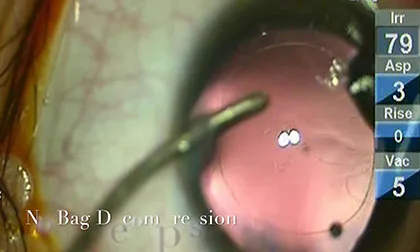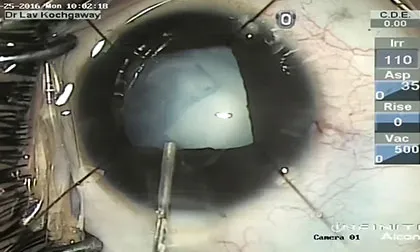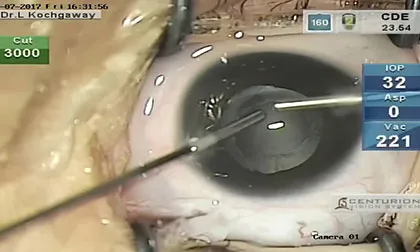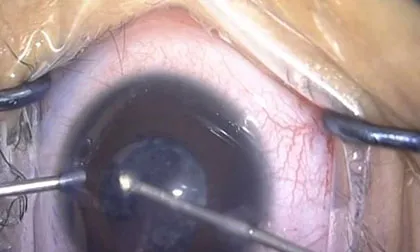
Experience Clearer Vision Today
Dr. Lav Kochgaway is a leading ophthalmologist in Kolkata, recognized for his expertise and extensive experience in performing advanced cataract surgery.
With over 20 years of dedicated practice and 16,000+ successful cataract procedures, Dr. Kochgaway offers his patients personalised care and exceptional outcomes.

What is Cataract Surgery?
A cataract is a clouding of the natural lens of your eye, affecting your vision. Cataract surgery is a safe and effective procedure that removes the clouded lens and replaces it with an artificial intraocular lens (IOL).
Benefits of Cataract Surgery:
- Improved vision and clarity
- Reduced dependence on glasses
- Enhanced quality of life
What are the Types of Cataracts?
- Nuclear Cataract: This is the most common type, occurring when the centre of the lens hardens and turns yellow or brown. It gradually blurs vision.
- Cortical Cataract: White, wedge-shaped opacities form on the lens’s outer edge. This type often causes blurry or distorted vision.
- Posterior Subcapsular Cataract: This develops at the back of the lens, often causing glare and difficulty with night vision. It progresses rapidly and can impact vision significantly.
- Congenital Cataract: Present at birth, this type can vary in severity and may affect one or both eyes. Early detection and treatment are crucial.
- Secondary Cataract: Developing after cataract surgery or due to other eye conditions, this type can cause vision to become cloudy again.
- Traumatic Cataract: Resulting from an eye injury, this type can range from mild to severe, depending on the injury’s severity.
Your Vision: Our Priority!
At Dr. Lav Kochgaway’s clinic, we offer advanced cataract treatment options tailored to individual patient needs. Our goal is to restore your vision and enhance your quality of life through minimally invasive techniques.
Laser Cataract Surgery: The Preferred Choice
Laser cataract surgery is an advanced treatment for cataracts that uses precise lasers for key steps, including making incisions and softening the cloudy lens. This minimally invasive technique often leads to quicker recovery times and improved vision outcomes. Additionally, patients often experience less discomfort during and after the procedure, enhancing their overall surgical experience.
Phacoemulsification
Phacoemulsification is the gold standard in cataract surgery, offering exceptional results and a swift recovery. This advanced procedure involves a micro-incision, significantly reducing discomfort and healing time. Our skilled surgeons utilise state-of-the-art technology to gently break up the clouded lens using ultrasound waves, removing it through suction, and implanting a clear artificial lens (IOL).
Manual Small Incision Cataract Surgery (MSICS)
In certain cases, MSICS may be recommended. This technique involves a slightly larger incision than phacoemulsification but is less invasive than traditional cataract surgery. While not as commonly performed as phacoemulsification, it remains a viable option for suitable patients.
Extracapsular Cataract Extraction (ECCE)
ECCE is a less common procedure due to its longer recovery time and increased risk of complications. However, in rare instances where phacoemulsification is not feasible, our experienced surgeons can perform ECCE.
Choosing the Right Lens for Your
Cataract Surgery
Once you’ve decided to undergo cataract surgery, selecting the appropriate intraocular lens (IOL) is crucial for achieving optimal vision outcomes. Dr. Lav Kochgaway will carefully assess your individual needs and preferences to recommend the best IOL option for you.
Types of IOLs:
Standard Monofocal IOLs: These traditional lenses provide clear distance vision but may require glasses for reading or intermediate tasks.
- Single-piece design: The central and peripheral portions are made of the same material.
- Multi-piece design: Offers flexibility in certain surgical situations.
Aspheric IOLs: Designed to reduce glare and halos, providing improved contrast sensitivity and clearer images.
- Examples: Acrysof IQ, Tecnis 3-piece, Tecnis 1
Premium IOLs: For patients seeking reduced dependence on glasses, premium IOLs offer advanced features.
- Toric IOLs: Correct astigmatism for improved distance vision without glasses. However, they may not fully address irregular astigmatism or provide optimal intermediate vision.
- Multifocal IOLs: Offer both distance and near vision, reducing the need for glasses. However, they may cause glare or halos and might not be suitable for all patients.
- Multifocal Toric IOLs: Combine the benefits of toric and multifocal lenses for patients with astigmatism and a desire for clear vision at multiple distances.
Factors to Consider When Choosing an IOL:
- Your lifestyle and vision needs: Consider your daily activities and desired level of visual independence.
- Your eye health: Certain eye conditions or previous surgeries may influence IOL options.
- Your expectations: Discuss your goals and concerns with Dr. Kochgaway to ensure your expectations are aligned with the chosen IOL.
Dr. Lav Kochgaway will provide personalised guidance to help you select the IOL that best suits your individual needs and lifestyle.
Video Library
FAQs
It’s recommended to have your child’s first eye exam around six months of age.
Common eye problems in children include lazy eye (amblyopia), strabismus (crossed eyes), and refractive errors (nearsightedness, farsightedness, astigmatism).
Lazy eye treatment often involves patching, glasses, or vision therapy. In some cases, surgery may be necessary.






